Project Categories: Small Boring Unit
Proyecto de suministro de agua a la ciudad de Kota
Descripción del proyecto
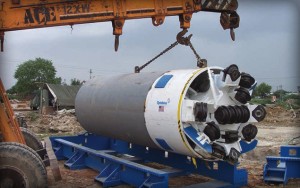 Tras sucesivos intentos fallidos durante un periodo de ocho años, únicamente restaban tres galerías en roca dura para finalizar una línea de suministro de agua a la ciudad de Kota en Rajasthan, India. Los contratistas a cargo habían intentado perforar las cuarcitas del proyecto utilizando técnicas manuales de minería o perforaciones dirigidas HDD, siendo ambos métodos abandonados debido a su muy bajo rendimiento. La excavación manual del foso de 11 x 4,5 m en planta se extendió durante cuatro meses con rendimientos de únicamente 200 a 300 mm al día. En 2008 se adjudicó al contratista Vichitra Constructions Pvt. Ltd. La construcción de estas galerías tan complicadas de 50 m de longitud.
Tras sucesivos intentos fallidos durante un periodo de ocho años, únicamente restaban tres galerías en roca dura para finalizar una línea de suministro de agua a la ciudad de Kota en Rajasthan, India. Los contratistas a cargo habían intentado perforar las cuarcitas del proyecto utilizando técnicas manuales de minería o perforaciones dirigidas HDD, siendo ambos métodos abandonados debido a su muy bajo rendimiento. La excavación manual del foso de 11 x 4,5 m en planta se extendió durante cuatro meses con rendimientos de únicamente 200 a 300 mm al día. En 2008 se adjudicó al contratista Vichitra Constructions Pvt. Ltd. La construcción de estas galerías tan complicadas de 50 m de longitud.
La conducción, de 13 km de longitud, es parte del programa gubernamental de desarrollo de infraestructuras en Rajashtan (RUIDP en sus siglas inglesas) y se utiliza para incrementar el suministro de agua de la ciudad al mismo tiempo que se lucha contra su contaminación. El sistema, una vez terminado, suministra 24 millones de litros al día a alrededor de 70000 personas.
Después de evaluar varias tecnologías, Vichitra adquirió una SBU-A Robbins de 1,5 m de diámetro equipada con cortadores de 11,5” así como una perforadora de tornillo ABM Robbins 60-1270). Dichas máquinas las suministró by Robbins Tunneling and Trenchless Technology (India) Pvt Ltd, una subsidiaria de The Robbins Company situada en Nueva Delhi y que también aportó al contratista servicio técnico, personal de obra y servicios de reparación de cortadores.
Geología
La mayoría de galerías atravesaban terrenos cuarcíticos con resistencias de 150 a 200 MPa, encontrándose algunas trazas de suelos y lodos.
SBU-A
Las unidades de perforación de pequeño diámetro (SBU-A), que Robbins fabrica en diámetros que van desde las 24” a las 72”, se utilizan principalmente para la excavación de galerías de menso de 150 m de longitud, complementadas por las perforadoras de tornillo (ABM) y la tubería de acero. La SBU-A se suelda a la tubería y la ABM proporciona el empuje y par necesarios para la excavación. La cabeza de corte circular se equipa con cortadores de disco sencillos para la excavación de roca dura, pudiéndose también utilizar combinaciones de dichos cortadores con cortadores de dos filas de botones de carburo o puntas de carburo simples para la perforación de terrenos mixtos. Los cortadores de disco penetran en el frente rocoso creando una zona de rotura desde donde se propagan las fracturas a la roca. El material situado entre dos zonas de rotura se desprende del frente, siendo recogido por cangilones que lo voltean a las aberturas de la cabeza, desde donde se transfiere a un transportador de tornillo sinfín para su evacuación.
Excavación de las galerías
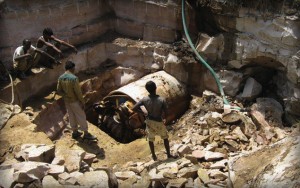 Se terminaron tres perforaciones en el otoño de 2008 en roca dura y abrasiva. Estas galerías, que pasaban debajo de vías ferroviarias, se excavaron en dos pasadas de 50 m de longitud desde ambos extremos. La primera pasada, en la que se obtuvieron avances de 1,5 m/h, caló en un foso central situado entre las dos vías a atravesar. Se realizó una tercera perforación de 14 m de longitud bajo una carretera ante las dificultades de realizar la excavación de la roca dura en trinchera.
Se terminaron tres perforaciones en el otoño de 2008 en roca dura y abrasiva. Estas galerías, que pasaban debajo de vías ferroviarias, se excavaron en dos pasadas de 50 m de longitud desde ambos extremos. La primera pasada, en la que se obtuvieron avances de 1,5 m/h, caló en un foso central situado entre las dos vías a atravesar. Se realizó una tercera perforación de 14 m de longitud bajo una carretera ante las dificultades de realizar la excavación de la roca dura en trinchera.
Milford Haven Gas Connection Project
Motorized SBUs Power through Rock on U.K. Pipeline
Project Overview
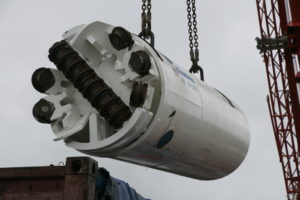 In one of the U.K.’s most extensive infrastructure developments, the Milford Haven Gas Connection Project extends over 300 km (190 mi) across South Wales. The pipeline was created to deliver liquefied natural gas (LNG) from a port at Milford Haven, providing up to 20% of the U.K.’s natural gas for owner National Grid.
In one of the U.K.’s most extensive infrastructure developments, the Milford Haven Gas Connection Project extends over 300 km (190 mi) across South Wales. The pipeline was created to deliver liquefied natural gas (LNG) from a port at Milford Haven, providing up to 20% of the U.K.’s natural gas for owner National Grid.
Constructed in two phases, work began on the pipeline in early 2006. Both phases were finished in November 2007. Phase I involved a 120 km (75 mi) long stretch from the towns of Milford Haven to Aberdulais. Phase II of the project extended the pipeline another 185 km (115 mi) from Felindre to Tirley in Gloucestershire.
General Contractor NACAP/Land & Marine constructed many of the crossings for both Phases I and II, subcontracting some hard rock crossings to local contractor B&W Tunnelling Ltd. B&W utilized three 1.2 m (48 inch) Robbins SBU-As and two 1.2 m (48 inch) Robbins SBU-Ms to excavate 62 crossings ranging from 20 to 80 m (65 to 260 ft) in length.
Geology
The majority of crossings were located in siltstone and mudstone rock (70 to 200 MPa/ 10,000 to 29,000 psi UCS), with some interbedded clay and gravel.
Motorized SBU
B&W Tunnelling opted for the Motorized SBU (SBU-M) due to the challenging contractual line and grade restrictions on their four longest bores. The 50 mm (2 in) tolerance meant they needed a machine with increased accuracy and continuous monitoring.
The Motorized SBU is a manned-entry, hard rock boring machine used for longer bores (over 150 m/ 500 ft in length) and for line- and grade-critical crossings. The machine is used in conjunction with a standard Auger Boring Machine (ABM) or pipe jacking unit and is welded to the lead casing in the same fashion as SBU-As. The machine is continuously steered from an operator’s console inside the rear shield, and uses a laser targeting system to monitor the machine’s heading.
B&W utilized two Motorized SBUs, one for hard rock and one for mixed ground. The mixed ground cutterhead featured 9.5″ diameter single disc cutters and larger muck openings to tackle the sections of rock interbedded with clay and gravels.
Tunnel Excavation
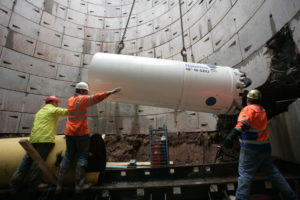 All crossings were excavated successfully, typically averaging from 1.5 to 2.0 m (5.0 to 6.5 ft) per hour. Each of the SBU-A crossings utilized a 1.2 m (48 inch) ABM and required shallow launch pits measuring 24 m (80 ft) long x 3 m (10 ft) wide. Incredibly, the three SBU-A machines completed 53 crossings of 30 m (100 ft) in length (a total of approximately 1,600 m/ 5,300 ft bored) with only a single cutter change.
All crossings were excavated successfully, typically averaging from 1.5 to 2.0 m (5.0 to 6.5 ft) per hour. Each of the SBU-A crossings utilized a 1.2 m (48 inch) ABM and required shallow launch pits measuring 24 m (80 ft) long x 3 m (10 ft) wide. Incredibly, the three SBU-A machines completed 53 crossings of 30 m (100 ft) in length (a total of approximately 1,600 m/ 5,300 ft bored) with only a single cutter change.
Each of the Motorized SBU crossings required the use of 10 to 30 m (33 to 100 ft) deep launch and recovery shafts. The 10.5 m (35 ft) diameter shafts were lined with concrete-bolted segmental rings and were used to install the pipeline after the crossing had been excavated. Sacrificial casing (steel, 1.2 m/ 48 in O.D.) was used to provide the necessary forward thrust to the cutting face from the ABM. The pipe was later removed and a semi-automatic welding bug was used to install the final pipeline.
Chester Boulevard Interceptor Sewer
Rockhead Makes Short Work of Indiana Crossings
Project Overview
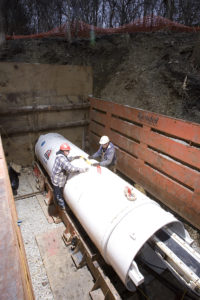 The city of Richmond, Indiana is a growing community of 50,000 people. To meet future projections, the city created a plan to double the current capacity of its sewer system via a 6.4 km (4 mi) long extension. The new gravity sewer would also eliminate the need for costly pump stations.
The city of Richmond, Indiana is a growing community of 50,000 people. To meet future projections, the city created a plan to double the current capacity of its sewer system via a 6.4 km (4 mi) long extension. The new gravity sewer would also eliminate the need for costly pump stations.
In December 2006, the Richmond Sanitary District awarded a USD $4.7 million contract to general contractor Brackney, Inc for construction of the Chester Boulevard Interceptor Sewer—a 3.2 km (2 mi) stretch of the new pipeline to provide service to a commercial district and nearby hospital. Subsequently, Midwest Mole, Inc. was subcontracted by Brackney to excavate four hard rock crossings underneath a river and historic walking trails. Midwest Mole opted to use a 1.2 m (48 inch) diameter SBU-A for the two shortest bores (55m / 180 ft in length), and a 1.4 m (54 inch) Single Shield Rockhead for the two longest bores of 120 m (400 ft) each.
Geology
The crossings were located in shale and limestone rock up to 70 MPa (10,200 psi) UCS. All of the crossings were in competent ground with little to no water inflows.
Rockhead
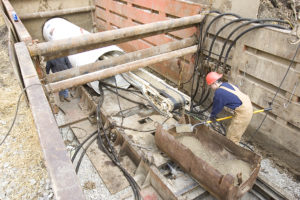 Rockheads are the most efficient technology for hard rock or mixed ground conditions from 25 to over 175 MPa (4,000 to over 25,000 psi) UCS that are above the water table. Midwest Mole decided on a Robbins Rockhead for the longest bores due to the length of the crossings and the strict line and grade requirements. Both crossings required accurate excavation at a grade of 0.25%–an easy feat for the Rockhead, which is continuously steered via an operator’s console inside the machine’s rear shield.
Rockheads are the most efficient technology for hard rock or mixed ground conditions from 25 to over 175 MPa (4,000 to over 25,000 psi) UCS that are above the water table. Midwest Mole decided on a Robbins Rockhead for the longest bores due to the length of the crossings and the strict line and grade requirements. Both crossings required accurate excavation at a grade of 0.25%–an easy feat for the Rockhead, which is continuously steered via an operator’s console inside the machine’s rear shield.
The cutterhead on the 1.4 m (54 inch) machine was fitted with 6.5″ diameter patented Single Disc Cutters for optimal boring in solid rock. The machine is owned by Midwest Mole and had been used on six previous projects since 2005. After boring over 1,200 m (3,900 ft), the machine was sent in to the Robbins shop for its first refurbishment and change of cutters prior to the set of gravity sewer crossings.
Tunnel Excavation
Midwest Mole excavated the first 120 m (400 ft) long crossing in March 2007. The Rockhead was welded to the lead 1.4 m (54 in) diameter steel casing and launched from the bore pit using a pipe jacking system. The machine averaged 6 to 8 m (20 to 26 ft) per 10-hour shift, finishing both on time and within grade requirements.The second crossing excavation began in May 2007, with the machine accomplishing even better excavation rates of up to 9 m (30 ft) per shift.
Both SBU-A crossings were finished with similar results. Each of the 55 m (180 ft) crossings, on a 0.42% grade, required continuous monitoring of the machine’s heading. Stabilizer pads, located in each quadrant of the machine, were used to stabilize the machine and allow for steering during the first 6 to 8 m (20 to 26 ft) of the bore. Crews adjusted the machine’s heading by changing the height of the stabilizer pads using a hydraulic cylinder. After the first 6 to 8 m (20 to 26 ft), monitoring alignment required the use of a dutch level. If the alignment had drifted the auger was then pulled and reset on the correct heading. The machine averaged up to 6 m (20 ft) per 10-hour shift on both crossings.
Túnel para cable de Glenwood
Descripción del proyecto
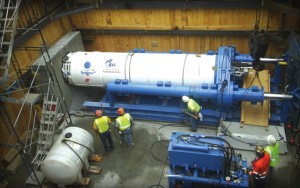 En 2006 se contrató a EIC Associates para la construcción de una línea de transporte de 115 kV de más de 13 km de longitud a través de Stamford, Darien, y Norwalk en Connecticut, EEUU. Una vez terminado, el sistema consta de tres circuitos con 92 cámaras y 62 asideros. EIC utilizó una cabeza de roca Robbins de doble escudo (SBU-RHDS) de 1,5 m de diámetro para perforar dos galerías bajo el ferrocarril Metro North en Darien, en lo que se demostró ser una roca particularmente difícil de abordar.
En 2006 se contrató a EIC Associates para la construcción de una línea de transporte de 115 kV de más de 13 km de longitud a través de Stamford, Darien, y Norwalk en Connecticut, EEUU. Una vez terminado, el sistema consta de tres circuitos con 92 cámaras y 62 asideros. EIC utilizó una cabeza de roca Robbins de doble escudo (SBU-RHDS) de 1,5 m de diámetro para perforar dos galerías bajo el ferrocarril Metro North en Darien, en lo que se demostró ser una roca particularmente difícil de abordar.
Dadas las muy malas condiciones del terreno, se contrató a G. Donaldson, una división de Hayward-Baker, Inc. para realizar inyecciones de consolidación de dos tipos: horizontal para estabilizar la alineación el túnel y vertical alrededor de la vía y sus estructuras para reducir los riesgos de asentamientos superficiales.
Geología
Los sondeos realizados en la zona de los túneles arrojaron resultados descriptivos de la muy fracturada monzonita metacuarcítica, con resistencias entre 35 y 140 MPa y RQD del 45% de media. Con estos datos, se replanteó la galería a 3 m adicionales de profundidad. De todas formas, los siguientes sondeos acreditaron la existencia de terrenos muy fracturados también a esa profundidad.
Cabeza de roca
Las cabezas de roca se suelen utilizar en galerías de longitud suficiente con requisitos estrictos de alineación, como en los colectores por gravedad. EIC eligió la mejor opción posible, una cabeza de roca Robbins de doble escudo dada la inestabilidad de la roca y la longitud de la perforación.
La máquina de doble escudo de 1,5 m de diámetro se diseñó específicamente para la excavación de terrenos fracturados, incluyendo una placa protectora de la cabeza de corte con ranuras para los cortadores de disco. Se enrejaron las aberturas de recogida de escombro para limitad el tamaño de roca a evacuar por el transportador.
Excavación del túnel
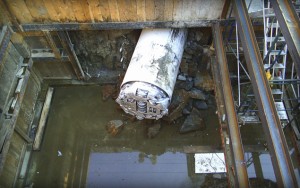 La perforación comenzó en la primavera de 2008, trabajándose seis días a la semana en dos turnos de 10 horas. La máquina perforó las dos galerías con medias de penetración de entre 254 y 635 mm/h, debido a la alta Resistencia de la roca. La máquina mantuvo la alineación requerida mediante su guiado por zapatas estabilizadoras y cilindros de articulación. EIC decidió utilizar tubería de hormigón armado para el revestimiento del túnel, que se instaló detrás del paso de la máquina mediante una unidad de empujado de tubos.
La perforación comenzó en la primavera de 2008, trabajándose seis días a la semana en dos turnos de 10 horas. La máquina perforó las dos galerías con medias de penetración de entre 254 y 635 mm/h, debido a la alta Resistencia de la roca. La máquina mantuvo la alineación requerida mediante su guiado por zapatas estabilizadoras y cilindros de articulación. EIC decidió utilizar tubería de hormigón armado para el revestimiento del túnel, que se instaló detrás del paso de la máquina mediante una unidad de empujado de tubos.
El personal de servicio ajustó los índices de penetración a lo largo de la excavación, ya que las zonas inyectadas representaban un terreno mucho más blanda y fácil de perforar. Los ajustes consistieron en la reducción de la presión de los cilindros de empuje o de la velocidad de la cabeza de corte, para evitar el taponado del sistema de evacuación de escombro con demasiado producto de la excavación. El accionamiento eléctrico de velocidad variable fue muy importante para la realización de estos ajustes con precisión durante la obra.
Mejoras sanitarias en Locust Street, proyecto No. 6335
Descripción del proyecto
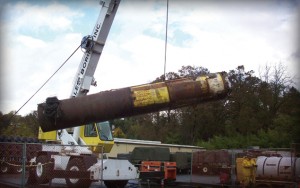 El contratista general Northwest Earthmovers Inc. ha construido más de 1,8 km de colectores por gravedad en la ciudad de Tigard, Oregón para la propietaria del proyecto Clean Water Services. La empresa Gonzales Boring & Tunneling fue subcontratada para la perforación de tres galerías, que formaban parte del proyecto nº 6335 de mejoras sanitarias en la calle Locust, de 70, 183 y 98 m de longitud respectivamente. La tubería a instalar, de 450 mm de diámetro, está destinada a incrementar laas capacidades de gestión de aguas residuales en la zona así como para evitar inundaciones.
El contratista general Northwest Earthmovers Inc. ha construido más de 1,8 km de colectores por gravedad en la ciudad de Tigard, Oregón para la propietaria del proyecto Clean Water Services. La empresa Gonzales Boring & Tunneling fue subcontratada para la perforación de tres galerías, que formaban parte del proyecto nº 6335 de mejoras sanitarias en la calle Locust, de 70, 183 y 98 m de longitud respectivamente. La tubería a instalar, de 450 mm de diámetro, está destinada a incrementar laas capacidades de gestión de aguas residuales en la zona así como para evitar inundaciones.
Gonzales Boring & Tunneling adquirió una SBU-A Robbins de 1,0 m de diámetro para perforar las tres galerías que atravesaban las calles del vecindario, sus viviendas, un pequeño arroyo y una fábrica.
Geología
La primera galería se situaba en terrenos de arcilla y basalto, mientras que la segunda atravesaba basaltos de resistencias entre 48 y 82 MPa. En algunas zonas se encontró arena y pequeños bloques de roca.
Características de la SBU-A
Las cabezas de corte Robbins SBU pueden equiparse con picas de carburo de tungsteno y cortadores de disco, sencillos o de varios discos, dependiendo de las condiciones del terreno a perforar. A la que nos ocupa se le montaron cortadores de disco simple de 6,5” de diámetro y se sobredimensionaron alas aberturas de evacuación de escombro a la vista de los terrenos mixtos a excavar.
Para arrancar se soldó la SBU-A a una tubería guía de acero. El empuje y par necesarios para el avance de la cabeza se lo proporcionó una perforadora de tornillo sinfín (ABM). Los cangilones de la cabeza recogían el escombro volteándolo al transportador sinfín para su evacuación al exterior.
Excavación del túnel
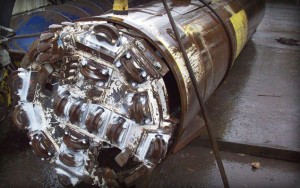 Bajo un estricto control de la alineación de la perforación por parte del personal del contratista, la máquina avanzó sostenidamente en índices de 12 m por turno de 10 h. El sistema de guiado ideado por el contratista permitió que la máquina calase con una desviación de solo una centésima de pulgada sobre su objetivo tras 183 m de excavación. Además de establecer un record de longitud en una única perforación, la máquina no necesitó reemplazar ni un solo cortador en 250 m de túnel. La máquina perforó una tercera galería del proyecto de 98 m de longitud a comienzos de 2010.
Bajo un estricto control de la alineación de la perforación por parte del personal del contratista, la máquina avanzó sostenidamente en índices de 12 m por turno de 10 h. El sistema de guiado ideado por el contratista permitió que la máquina calase con una desviación de solo una centésima de pulgada sobre su objetivo tras 183 m de excavación. Además de establecer un record de longitud en una única perforación, la máquina no necesitó reemplazar ni un solo cortador en 250 m de túnel. La máquina perforó una tercera galería del proyecto de 98 m de longitud a comienzos de 2010.
Big Sky
Descripción del proyecto
The Yellowstone Club, una instalación privada de recreo en Big Sky, Montana, dispone de un campo de golf de montaña de 18 hoyos además de muchos kilómetros de pistas de esquí de fondo. La irrigación del campo de golf se realiza a través de una tubería de 97 m de longitud que transporta el agua de un embalse cercano de 79 millones de galones de capacidad.
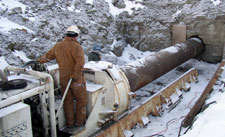 En 2005, el Club contrató a Tunnel Systems Inc. para la perforación de la tubería. El contratista comenzó la obra utilizando una ABM con cabeza de corte triangular, pero a los 18 m de perforación se empezaron a experimentar problemas al encontrarse terrenos de roca dura. En los dos días siguientes, la máquina fue capaz de perforar únicamente 4,9 m, por lo que Tunnel Systems Inc. decidió alquilar una SBU Robbins de 762 mm de diámetro.
En 2005, el Club contrató a Tunnel Systems Inc. para la perforación de la tubería. El contratista comenzó la obra utilizando una ABM con cabeza de corte triangular, pero a los 18 m de perforación se empezaron a experimentar problemas al encontrarse terrenos de roca dura. En los dos días siguientes, la máquina fue capaz de perforar únicamente 4,9 m, por lo que Tunnel Systems Inc. decidió alquilar una SBU Robbins de 762 mm de diámetro.
Geología
El tramo de roca dura que nos ocupa constaba tanto de roca maciza como de terrenos mezclados con suelos.
SBU
Tunnel Systems eligió una SBU Robbins para el proyecto ya que se trata de la máquina idónea para enfrentarse a rocas muy duras, en este caso de más de 240 MPa de resistencia a la compresión. La máquina utilizada no estaba equipada de zapatas de estabilización, algo estándar en casi todas las SBU Robbins. La máquina iba equipada con los cortadores de disco patentados por Robbins, estando basada su tecnología en la de las tuneladoras de gran diámetro.
Excavación del túnel
Se soldó la SBU a su tubería guía de acero en obra. El empuje a la SBU se suministraba a través de la propia tubería mientras que la ABM proporcionaba el par necesario para el avance. El escombro se evacuaba a través del transportador sinfín del sistema.
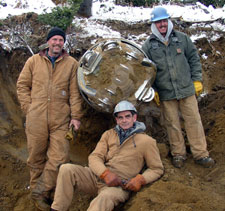 Desde el mismo comienzo de su cometido, la SBU alcanzó registros de avance impresionantes de entre 13 y 15 m/día. La perforación se realizó en roca durante 60 m para pasar a terrenos mixtos con suelos en los 6 m finales de la galería.
Desde el mismo comienzo de su cometido, la SBU alcanzó registros de avance impresionantes de entre 13 y 15 m/día. La perforación se realizó en roca durante 60 m para pasar a terrenos mixtos con suelos en los 6 m finales de la galería.
La SBU terminó su proyecto en plazo a pesar de varias dificultades, como las muy bajas temperaturas en obra (de -7º C) con vientos de 65 km/h y tormentas de nieve. Una vez pasada la tormenta, la galería se completó al día siguiente tras unas pocas horas de trabajo.
Tahoe Forest Hospital District Central Energy Plant Prep Project
Project Overview
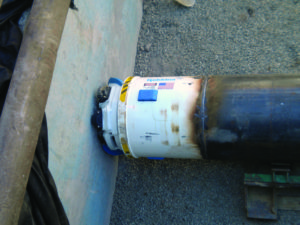 The Tahoe Forest Hospital is an expanding healthcare center located in Truckee, California. In autumn 2010, they were in the process of designing a new cancer wing when it was determined that additional utility and mechanical lines were required before the new building could be built. To house the bundled utilities, three crossings needed to be bored directly below the active main hospital.
The Tahoe Forest Hospital is an expanding healthcare center located in Truckee, California. In autumn 2010, they were in the process of designing a new cancer wing when it was determined that additional utility and mechanical lines were required before the new building could be built. To house the bundled utilities, three crossings needed to be bored directly below the active main hospital.
General contractor AM-X Construction & Excavation, Inc. subcontracted the three parallel 21 m (70 ft) sections to Silver State Boring Inc. Due to variable ground conditions and hospital noise constraints, the contractor opted for a Robbins SBU-A with a mixed ground head. This was the first time Silver State had used this type of cutterhead, but they were confident that it was the right machine for the job.
Geology
The hospital is set on ground containing large granite boulders, and Silver State was worried that one of these rocks would be hit during boring. This concern was actualized 7.6 m (25 ft) into the first bore when the SBU-A caught the edge of a boulder about 3.7 m (12 ft) in diameter. During the second bore, the machine drilled straight through the same boulder. Additional boulders of 175 MPa (25,000 psi) UCS were encountered during the third bore, and the SBU-A successfully powered through them as well.
What is a Mixed Ground SBU-A?
The Robbins SBU-A is a circular cutting head mounted with a combination of tungsten carbide bits, single disc cutters, and multi-row disc cutters. The SBU-A is available in diameters from 600 mm to 1.8 m (24 to 72 in), and can excavate a wide variety of hard rock and mixed ground conditions including dry soils, clay, cobbles and boulders from 25 to 175 MPa (4,000 to 25,000 psi) UCS.
During boring, the SBU-A is welded to an Auger Boring Machine (ABM), which provides both torque and thrust to the cutting head. Drag bits scrape soil from the machine face, while disc cutters excavate sections of rock. Muck scrapers scoop the excavated rock into large openings in the cutterhead, allowing for a smooth flow of muck from the face to the auger string.
Excavation
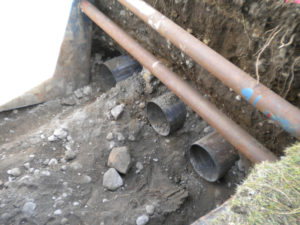 The SBU-A bored 2 m (8 ft) below the hospital’s foundation for the three jack-and-bore crossings. Straight bores were needed due to tight exit space, and each one began with a 609 mm (24 in) thick concrete starting block to keep the machine properly aligned. In addition, the older hospital has many buried utilities that needed to be cut and bypassed during site excavation. To make sure that everything would run smoothly, Robbins field service technicians visited the site prior to launch to assist with setup and crew training.
The SBU-A bored 2 m (8 ft) below the hospital’s foundation for the three jack-and-bore crossings. Straight bores were needed due to tight exit space, and each one began with a 609 mm (24 in) thick concrete starting block to keep the machine properly aligned. In addition, the older hospital has many buried utilities that needed to be cut and bypassed during site excavation. To make sure that everything would run smoothly, Robbins field service technicians visited the site prior to launch to assist with setup and crew training.
The first of the three bores began in October 2010, and by November 2010 all three bores were successfully completed. Advance rates for the duration of the project were approximately 3 m (10 ft) per day.
Due to the low torque and impact of the SBU-A, little stress was put on the ABM, no cutter changes were needed between bores, and the hospital was unaffected by noise or vibration during boring. Silver State was very pleased with the results, and used the technology again in 2011 for 609 mm (24 in) diameter bore in South Lake Tahoe, Nevada.
City of Clinton Contract B Force Main Project
Project Overview
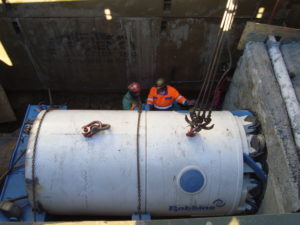 The Iowan towns of Clinton, Camanche and Low Moor have been identified as communities in desperate need of updated wastewater treatment systems. The towns all have over 10,000 residents, but their water and sewer treatment plants are inadequate and often over capacity. In 2009, a statewide recovery program called I-JOBS was created in Iowa, and USD $20 million in project funding was allocated to improving water quality. These funds were set aside for water treatment projects in the three towns.
The Iowan towns of Clinton, Camanche and Low Moor have been identified as communities in desperate need of updated wastewater treatment systems. The towns all have over 10,000 residents, but their water and sewer treatment plants are inadequate and often over capacity. In 2009, a statewide recovery program called I-JOBS was created in Iowa, and USD $20 million in project funding was allocated to improving water quality. These funds were set aside for water treatment projects in the three towns.
The City of Clinton awarded their portion of the funding, USD $9.5 million, to general contractor Merryman Excavation. Illinois-based L.J. Keefe Co. was chosen as the sub-contractor for the project. The contract, known as City of Clinton Contract B Force Main, called for six crossings below roadways and rivers, three of which required TBM tunneling. The remaining three crossings required SBUs. Two Robbins SBU-As were chosen for the 26.2 m (250 ft) and 82.3 m (270 ft) runs, and a third Robbins motorized SBU (SBU-M) was selected for the 120.4 m (395 ft) crossing.
Geology
The 26.2 m (250 ft) and 82.3 m (270 ft) crossings undercut the Mississippi river, and were identified as hard rock bores of over 70 MPa (10,000 psi) UCS in which SBU-As would be the best choice. The longest crossing was below traffic-heavy Highway 67, and testing of the area revealed a mixed face of sand, clay and 70 MPa (10,000 psi) UCS hard rock. Due to the variable ground conditions, the contractor opted for a 1.8 m (72 in) SBU-M, the largest of its kind yet built.
About the SBU-A
The Small Boring Unit (SBU-A) is a hard rock and mixed ground circular cutterhead which utilizes an Auger Boring Machine (ABM) and steel casing. During excavation, the SBU-A is welded to the lead casing while the ABM provides torque and forward thrust to the cutterhead.
The SBU-A is available in diameters ranging from 600 mm to 1.8 m (24 to 72 in), and its single disc cutters are capable of excavating rock from 25 to over 175 MPa (4,000 to over 25,000 psi) UCS. The cutters penetrate the rock face, creating a “crush zone” through which fractures occur. Material between adjacent crush zones falls from the face into muck buckets in the cutterhead. A full face auger is used to transfer the muck for removal.
About the SBU-M
The SBU-A’s cousin, the SBU-M, is a motorized SBU used for longer bores and line-and-grade critical crossings. In similar fashion to the SBU-A, the SBU-M is welded or bolted to the lead casing of an ABM. The machine is continuously steered by way of an operator’s console in the rear shield. A laser targeting system is used to monitor the machine’s heading. These features allow for increased accuracy and continuous monitoring, which was needed on the 120.4 m (395 ft) bore due to the mixed ground geology, strict line-and-grade requirements, and crossing length.
Excavation
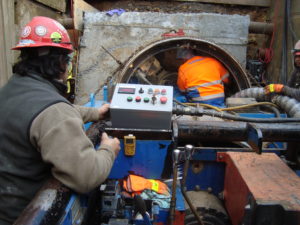 In November and December 2011, the 1.5 m (60 in) and 1.06 m (42 in) SBU-As, respectively, were launched 9.1 m to 10.6 m (30 to 35 ft) beneath a tributary of the Mississippi River. Each utilized an 18.3 m (60 in) ABM to excavate in the hard rock conditions. Both SBU-As broke through on time and within line-and-grade specifications. The first SBU reached completion on December 20, 2011, and its counterpart did the same on February 10, 2012. Each averaged advance rates of 6.1 m (20 ft) per day.
In November and December 2011, the 1.5 m (60 in) and 1.06 m (42 in) SBU-As, respectively, were launched 9.1 m to 10.6 m (30 to 35 ft) beneath a tributary of the Mississippi River. Each utilized an 18.3 m (60 in) ABM to excavate in the hard rock conditions. Both SBU-As broke through on time and within line-and-grade specifications. The first SBU reached completion on December 20, 2011, and its counterpart did the same on February 10, 2012. Each averaged advance rates of 6.1 m (20 ft) per day.
The 1.8 m (72 in) SBU-M was launched in January 2012 from a 7.6 m (25 ft) launch pit. Although the machine encountered an unexpectedly long drive of hard clay just 4.6 m (15 ft) into its bore, crews were able to keep moving by adding water through the cutterhead and the casing. This kept the muck coming through without contaminating the disc cutters.
Although challenging, advance rates of 6.2 m (20 ft) per day were maintained in the softer ground conditions. After about 70.1 m (230 ft) worth of clay, the machine hit solid rock for the remainder of the run. While in hard rock, rates increased to about 90.1 m (30 ft) per day.
On February 14, 2012, the SBU-M broke through into a receiving pit. It finished within line-and-grade requirements with very little deviation, even in the mixed face ground conditions during initial boring.
Shayler Run Segment C Sewer Replacement Project
Project Overview
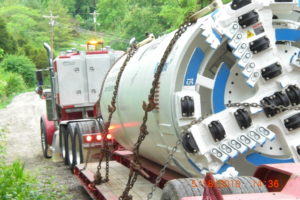 Seven new sewer tunnels were recently completed in Ohio’s Clermont County, replacing an outdated and exposed system that was dumping raw sewage into local Shayler Creek. Since 1978, when the previous pipeline was installed, the creek had eroded, exposing the pipe and putting certain sections of the line at high risk of failure. For all of these reasons, a new pipeline needed to be installed far below the environmentally-sensitive waterway.
Seven new sewer tunnels were recently completed in Ohio’s Clermont County, replacing an outdated and exposed system that was dumping raw sewage into local Shayler Creek. Since 1978, when the previous pipeline was installed, the creek had eroded, exposing the pipe and putting certain sections of the line at high risk of failure. For all of these reasons, a new pipeline needed to be installed far below the environmentally-sensitive waterway.
The Clermont County Water Resources Department hired Indianapolis contractor Midwest Mole for the $15M USD project, and chose to use only one machine for the seven tunnels. A 1.8 m (72 in) diameter Robbins Double Shield Rockhead was used to excavate all of the tunnels, totaling 2,900 m (9,513 ft). The contractor’s unique approach also included eliminating three shafts from the original bid, which shortened the project schedule and significantly lowered costs.
Ground Conditions
Because of the project location below the creek bed, ground conditions were highly varied, consisting of interbedded layers of limestone and shale that ranged from dry to sticky and wet. To accommodate the mixed ground, the machine was outfitted with a mixed ground cutterhead that could be swapped out for a hard rock cutterhead based on the ground conditions at each crossing.
The mixed ground cutterhead featured 6.5 in single disc cutters and carbide bits, while the hard rock cutterhead contained 11.5 in single cutters and abrasion-resistant muck scrapers. Both cutterheads had large openings which allowed for efficient cutter changes.
About the SBU-RHDS
The Robbins Double Shield Rockhead (SBU-RHDS) is a tunneling machine typically used on utility installations of over 150 m (500 ft). Its continuous steering capabilities and laser targeting system make it the ideal solution for line-and-grade critical installations such as the Shayler Run Segment C Sewer Replacement Project.
The SBU-RHDS is available in diameters from 1.4 to 2.0 m (54 to 78 in), and consists of a cutterhead optimized for mixed and hard rock ground conditions. The machine’s circular cutterhead contains disc cutters capable of excavating ground ranging from 25 to 175 MPa (4,000 to over 25,000 psi) UCS.
As the cutterhead rotates, the cutters penetrate the rock face creating “crush zones” through which fractures propagate. Material between adjacent crush zones is then chipped from the face. Muck scrapers scoop the muck into muck buckets, which transfer the muck onto a machine belt conveyor. Muck is transported offsite via conveyor belt or muck cars.
Excavation
 A total of seven tunnel crossings connected by eight shafts were constructed by Midwest Mole. The tunnels utilized the Rockhead, while the shafts were constructed using a combination of drill and blast techniques and manual excavation. A primary liner of ring beams and lagging was installed every 1.5 m (5 ft) at each crossing. Even with liner installation, high production rates of 12 to 18 m (40 to 60 ft) per 12-hour shift were maintained for the project duration.
A total of seven tunnel crossings connected by eight shafts were constructed by Midwest Mole. The tunnels utilized the Rockhead, while the shafts were constructed using a combination of drill and blast techniques and manual excavation. A primary liner of ring beams and lagging was installed every 1.5 m (5 ft) at each crossing. Even with liner installation, high production rates of 12 to 18 m (40 to 60 ft) per 12-hour shift were maintained for the project duration.
Due to the gravity sewer construction, each tunnel had strict line-and-grade requirements of within 300mm (1 ft) of line at 1 to 2% grade, which was continuously monitored from an in-shield operator’s console. Over the course of the project, the variance resulted in a vertical change of 53.9 m (177 ft) causing the machine to bore through a wide range of ground conditions.
Excavation of the initial 484.3 m (1,589 ft) crossing began in May 2010 in mixed ground, and the Rockhead broke through to its first shaft site that August. After a few minor modifications to the hydraulic and muck haulage systems, the machine began boring the second 575.4 m (1,888 ft) crossing.
Crossings 3 and 4, 321.9 m (1,056 ft) and 304.8 m (1,000 ft), respectively, were excavated in December 2010 and January 2011 in adverse winter weather conditions. In order to keep tunneling during freezing temperatures, the contractor heated the machine’s cooling water overnight. Cooling water was recycled and filtered, then stored in 7, 500 l (2,000 gal) tanks with heaters. Using this technique, production rates stayed high and both crossings were successfully excavated by January 2011.
The Rockhead began its fifth and longest crossing of 613.8 m (2,014 ft) in April 2011, and reached a world record in tunneling distance for a hard rock machine of its 1.8 m (72 in) diameter. For the last two crossings, 402.3 m (1,320 ft) and 196.9 m (646 ft), respectively, the mixed ground cutterhead was replaced with its hard rock counterpart.
Due to negotiations with local landowners and a change in shaft location, the final crossing began in January 2012. A month later, the drive was completed. In July 2012, the entire project reached completion right on schedule, with all manholes and ancillary sewers tied in and in service.
- Twin Robbins EPBs make milestones near Taj Mahal
- Long Haul TBM: Use of a Rebuilt Main Beam Machine at the DigIndy Tunnel System in Indianapolis, IN
- Evaluating TBM Design and Performance, 30 Years Apart: The Lesotho Highlands Water Tunnel, Phase 1 and Phase 2
- Overcoming Mountainous Geology at Nepal's Sunkoshi Marin Project
- Swift Robbins TBM breaks through 11 Months Early

 Close
Close  Menu
Menu 